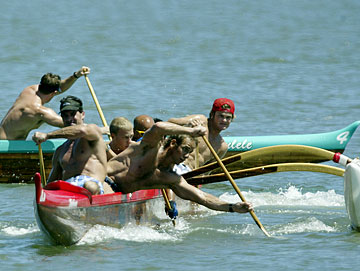
STAR-BULLETIN / JULY 2005
After the recent sewage spill, paddlers are concerned about water quality not only in the Ala Wai, but in Keehi Lagoon, where many races are held. The Men's Senior event at the OHCRA Championships was held at Keehi Lagoon in July.
|
|
Paddlers steer clear of Ala Wai
Club organizations want clarity and assurance from the state before returning to the canal
Oahu's two Hawaiian outrigger canoe-racing organizations expect to meet tomorrow with state and city officials to learn more about the safety of water at practice sites -- especially the Ala Wai Canal.
All 11 clubs that normally train in the canal or at Magic Island have moved practices elsewhere since 48 million gallons of raw sewage were spilled in the canal last month.
Clubs normally begin training for the summer regatta season in April, but participation this year has been light, as parents worry about their children's health and even seasoned adult paddlers question going into polluted water, said Tamry Young, president of Na 'Ohana O Na Hui Wa'a, an association of 16 clubs.
"I have had people approach me and say, 'Maybe we should call off the season,'" Young said.
A pre-season long distance race originally set for yesterday -- the Waikiki Beach Boys/Owen Cenal Memorial Race -- was canceled because of lingering concerns about water quality at the Magic Island end of the race.
Hui Wa'a and the Oahu Hawaiian Canoe Racing Association, which has 18 member clubs, together have thousands of members participating in the "state sport," said OHCRA President Hannie Anderson.
"Our concerns are great," Anderson said. "We'd like to return, but don't think we can until the water has cleared."
Members of clubs that have relocated temporarily are having difficulty with getting to the different locations, which include Keehi Lagoon, Kaimana Beach and the Hawaii Kai boat ramp.
Paddlers are concerned about water quality not only in the Ala Wai, but in Keehi Lagoon, where many races are held, and at Windward locations that had smaller, but significant sewage spills during a 43-day stretch of heavy rain that started in February and continued to early this month.
Kailua and Waimanalo beaches were cleared by the state Health Department for swimming only last week and warning signs remain up at the site of a spill on Kaneohe Bay and on the Ala Wai Canal.
"The water quality in the Ala Wai has not been good for years," Anderson said. "No one would dare go swimming in there" and paddlers would shower off after practices, she said.
But counts of Enterococci indicator bacteria soared as high as 780,000 colony forming units per water sample after the March 24-30 spill into the Ala Wai. The state's standard for acceptable swimming waters is not to be higher than 100 colony forming units in a single sample and not more than 7 over a period of five samples averaged by a geometric mean.
The presence of high quantities of indicator bacteria in water samples reflect the relative risk of getting sick from harmful pathogens found in sewage.
The executive boards of the canoe associations want health officials to tell them exactly when the water will be safe -- and how to interpret the test results.
Association leaders expect to pass on what they learn at a meeting Tuesday of representatives of all Oahu clubs, said Hiram Manoi Jr., head coach of the Kumulokahi-Elks Canoe Club.
Manoi said his all-youth club that normally has about 50 members had just eight kids show up for the first practice last week -- even though they are practicing at Kaimana Beach instead of Magic Island.
"Parents are waiting to see that contamination is really clean," he said.
Manoi said he wonders if water samples taken in the mornings are legitimate indicators of pollution in the late afternoon, which is practice time.
And Anderson said she wants the state to test the sludge at the bottom of the Ala Wai for bacteria.
Paddling leaders aren't sure yet whether any clubs will ever return to practice on the Ala Wai. Said Anderson: "They're going to be very, very hesitant about going back into that water."

